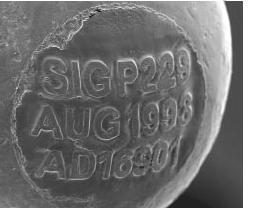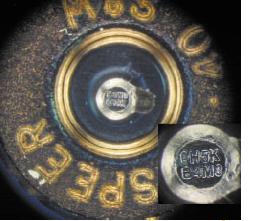 |
Interesting Articles about Popular Topics |
|
|
Dave Carlson - September 20, 2006 “Like fingerprints, toolmarks, including their most prominent manifestation as bullet markings, have always been accepted as inherently individualizing evidence” (Inman & Rudin, 2001, p. 52). The complex and irregular markings left on a bullet by the barrel and various moving parts of a firearm ensure a statistically unique picture of the mechanical process of a bullet being fired from a specific weapon (Inman & Rudin, 2001, p. 53). What makes this process so credible is that the unique marks left by a firearm on bullet and cartridge cases it fires, is that these unique marks are 100% reproducible (Gorovitz, 2004, p. 3). These marks, known as ballistic fingerprints, remain the same whether they were created at a crime scene or in a police lab. A ballistics expert can testify in court that marks created by six test discharges of a firearm in a lab exactly match marks on a single bullet recovered from a crime scene. The expert can testify with reasonable certainty that all the samples originated from the same firearm. There are two groups of identifying marks used in ballistic fingerprinting: marks on the bullet and marks on the cartridge case. Identifying features left on the cartridge case include the firing pin impression, breech marks, ejector marks, and collision marks (Gorovitz, 2004, p. 5). The outside diameter of a bullet is slightly larger than the inside diameter of a barrel designed for a bullet that size. Upon being fired, the bullet scrapes along the inside of the barrel. This action marks on the bullet (Gorovitz, 2004, p. 5). Marks left on the bullet by the barrel are called impressions. Additionally, these “impressions contain microscopic scratches, called striations, caused by imperfections” (Gorovitz, 2004, p. 5) of the inside surface of the barrel. Forensic examiners use the number, direction, and shape of these impressions and striations to determine the type of gun used to fire the bullet (Gorovitz, 2004, p. 5). After locating a suspected gun, examiners can match bullets fired from that gun to compare with bullets recovered from the crime scene. The physical action of loading, firing, and voiding a gun leaves marks on the cartridge case. Breech marks are created when the breech contacts the base of the cartridge to hold it in pace during firing. Upon firing, the firing pin strikes the primer in the cartridge case, leaving a unique impression. When the cartridge is ejected, the collision between the ejector mechanism and the cartridge case leave identifying marks. Sometimes friction or impact between the cartridge case and the interior of the firing chamber leave marks (Gorovitz, 2004, p. 5). An entire collection of marks on a cartridge case creates a unique picture of a discharge cycle for a specific weapon. The forensic potential of these marks “became recognized during the latter half of the 19th century, and by the 1920’s such evidence was appearing in criminal trials around the country” (Gorovitz, 2004, p. 6). Forensic investigators still can use ballistic fingerprints when they recover bullets or cartridge cases from a crime scene, but are unable to find a matching firearm (Gorovitz, 2004, p. 7). “In these cases, the ballistic fingerprint allows forensic examiners to connect shootings that might otherwise appear unrelated” (Gorovitz, 2004, p. 7). The examiners can compare bullets and cartridge cases found at different crime scenes to establish if the same firearm was used at both locations (Gorovitz, 2004, p. 7). Since the mid-1990’s computer technology has been employed in forensic examination of ballistic evidence (Gorovitz, 2004, p. 8). Digital images of cartridge cases and bullets previously identified can be cataloged to compare with cartridge cases and bullets recovered from new crime scenes. As forensic examiners migrated into the 21st century, they combined various systems into the National Integrated Ballistic Information Network (NIBIN) (Gorovitz, 2004, p. 9). As of 2004, “194 state and local law enforcement agencies are connected to NIBIN through 228 terminals” (Gorovitz, 2004, p. 9). This tool allows an investigator to compare new ballistic crime scene evidence with cartridge cases and bullets from past cases in a few minutes. Firearms manufactures are beginning to design identifying marks for weapons to aid in the identification of a specific firearm (Gorovitz, 2004, p. 3). A specific example of this unique identification is the incorporation of microstamps on the tip of a firing pin (see Figure 1 and Figure 2) to mark the primer of rounds fired from that firearm (Gorovitz, 2004, p. 16).  (Gorovitz, 2004, p. 16)  (ID Dynamics, LLC [NanoVia Ballistic Program Acquisition]) (Gorovitz, 2004, p. 16) An interesting non-ballistic use of toolmark examination is in the identification of tools employed in the creation of graves used to conceal murder victims. Studies cited by Haglund and Sorg (2002) revealed that “thin profile instruments such as crowbars, pitchforks, and screwdrivers” (p. 55) tended to preserve underground root networks, while “broad-bladed instruments such as shovels tended to slice, or tear, roots at the interface of the pit fill and pit wall leaving root segments in the fill and a larger percentage of severed roots at the interface” (p. 55). Identification of the type of tool used in the construction of a grave may help law enforcement officials match a tool owned by a suspect, especially if trace evidence on the tool matches the materials in the grave. Perhaps some day firearms and toolmark examiners and fingerprint examiners will be forced to provide the courts with certified scientific studies to support their testimony (Inman & Rudin, 2001, p. 54). Until that time, however, both fingerprint and toolmark identification will continue to rely on their undisputed professional opinion of absolute certainty. Gorovitz, E. (2004). Cracking the case: The crime-solving promise of ballistic identification. [Electronic version]. A report in the Closing Illegal Gun Markets series by The Educational Fund to Stop Gun Violence. Haglund, W. D. and Sorg, M. H. (Eds.) (2002). Advances in forensic taphonomy: Method, theory, and archaeological perspectives. Boca Raton, FL: CRC Press. Inman, K. and Rudin, N. (2001). Principles and practices of criminalistics: The profession of forensic science. Boca Raton, FL: CRC Press. |
||||
|